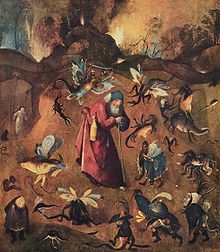Demonology
![]()
This article is about the theory of demons; for the book, see Daemonology.
![]()
This article or section is still missing important information. Help Wikipedia by researching and adding it.
Demonology is the theory of demons, i.e. evil spirits, as it can be reconstructed in the history of religion or explicitly formulated in documents of cultural history. Systematic accounts of Christian theology at times included a doctrine of demons as an appendix to angelology, since demons are conceptualized as fallen angels whose treatment is in turn subordinate to creation theology, with the dogmatic treatment of material usually extending to other tracts such as soteriology or Christology. Treatments of demons that are more likely to be located in the realm of magic, popular piety, or theurgy (as opposed to religious cult) often list, for example, techniques of influence and defense in addition to cataloging.
Term History
While the Greek expressions δαίμων (daímon) and δαιμόνιον (daimónion) initially referred to both good and evil divine or numenal beings, the meaning of the word in the sense of an evil spirit has predominated since the demonology of Xenocrates.
The term "demons" is used in a variety of ways, for example for "former gods", "beings that embody threatening counter-worlds or cause illness", for "supernatural communication mediators" or "border crossers between gods and humans".
History of Ideas
Ancient
In various cultures, the idea is found that various harms that befall man are caused by evil spirits. A systematization of these harmful spirits can be made according to a typology of these effects: Sexual demons cause e.g. infertility etc.
Bible
According to the fluctuating use of the term "demons" and the lack of any exact equivalent in Semitic languages, a survey of the Old Testament is more difficult. In many cases, among the widely developed ideas of mischief-causing spirits, parallel ideas to nearby cultures such as the Iranian religion have been pointed out, for example for Lilith (Isa 34:14 ELB) and the Babylonian Lilitu.
In ancient Judaism (as well as in the New Testament), events in the heavens are attributed not to gods but to demons.
In the New Testament text corpus there are various references to common demon concepts, especially with ancient Judaism. Sometimes also connections to Middle Platonic, Stoic or other Hellenistic demonological assumptions were attempted to be pointed out. Peter Busch, for example, saw in the Epistle to the Hebrews a transformation of elements of Middle Platonic demonology into Christological attributes: "passed through the heavens" (Heb 4:14 EU) refers to the dwelling place of the demons; these have priestly features (so Plutarch) and human affects (Middle Platonism, Stoa); for v. 15 he points to a Middle Platonic debate about the sinlessness of the demons.
In Pauline texts an acceptance of demons is indeed formulated, but above all it is declared to be theologically meaningless.
Christian Patristics
The patristic theologians discuss demons primarily in terms of the soteriological question of what we are redeemed from.
Latin Middle Ages
Medieval theologians continue the questions handed down from the patristic and transitional periods and also include the christological question of how Christ overcomes the devil as well as the anthropological question of how original sin is to be understood. Augustine did not question the real existence of demons. He advocated the doctrine of fallen angels. He was essentially followed by Isidore of Seville in his Etymologiae. Rabanus Maurus was also in this tradition with his treatise De magicis artibus, where both De divinatione daemonum of Augustine and Isidore's Etymologiae are received. Rabanus Maurus' statements were incorporated into the Decretum Gratiani in the 12th century. Augustine had also advocated the doctrine of the Covenant of Demons, which thus became an integral part of scholastic theology in the High Middle Ages and also found its way into the Decretum Gratiani (cf. C.26 q.2 c.6 §5).
European Modernity and Modernity
In a widely acclaimed book, British historian Stuart Clark has demonstrated that belief in demons was an important part of the understanding of nature in the early modern period. According to Clark, demonology was a "physics" that offered generally accepted explanations for natural phenomena. Stuart Clark's assessment turned against older historical scholarship, which viewed demonology primarily as something opposed to natural science. Since Clark's study, the similarity of explanatory models with different basic assumptions has been emphasized rather than their difference. Demon belief is of particular importance in the context of witchcraft. The pact with the devil was a basic prerequisite for the acquisition of magical abilities, which in turn were a form of influencing nature. According to church doctrine, devils and demons had no supernatural abilities. At the latest since the condemnation of the dualistic heresy by the Fourth Lateran Council, only God could have such abilities.
Authors of the 19th century have often tried to classify and interpret the belief in demons in terms of historical philosophy or religious history and evolution in relation to preliminary stages or subsequent stages and categories such as animism, polytheism, monotheism. According to today's historical view, these attempts of interpretation hardly do justice to the abundance of evidence.
In twentieth-century theology, also in reaction to efforts to "demythologize" the traditional material, demons are rarely dealt with explicitly. It is discussed, for example, to what extent the traditional ideas are to be reinterpreted in terms of "demonic structures", or to what extent a "personal" point of view is to be maintained.
.jpg)
Nikolaj Abraham Abildgaard: Mareridt, 1800.

Imitator of Hieronymus Bosch: The Temptation of St. Anthony, c. 1500.
Search within the encyclopedia